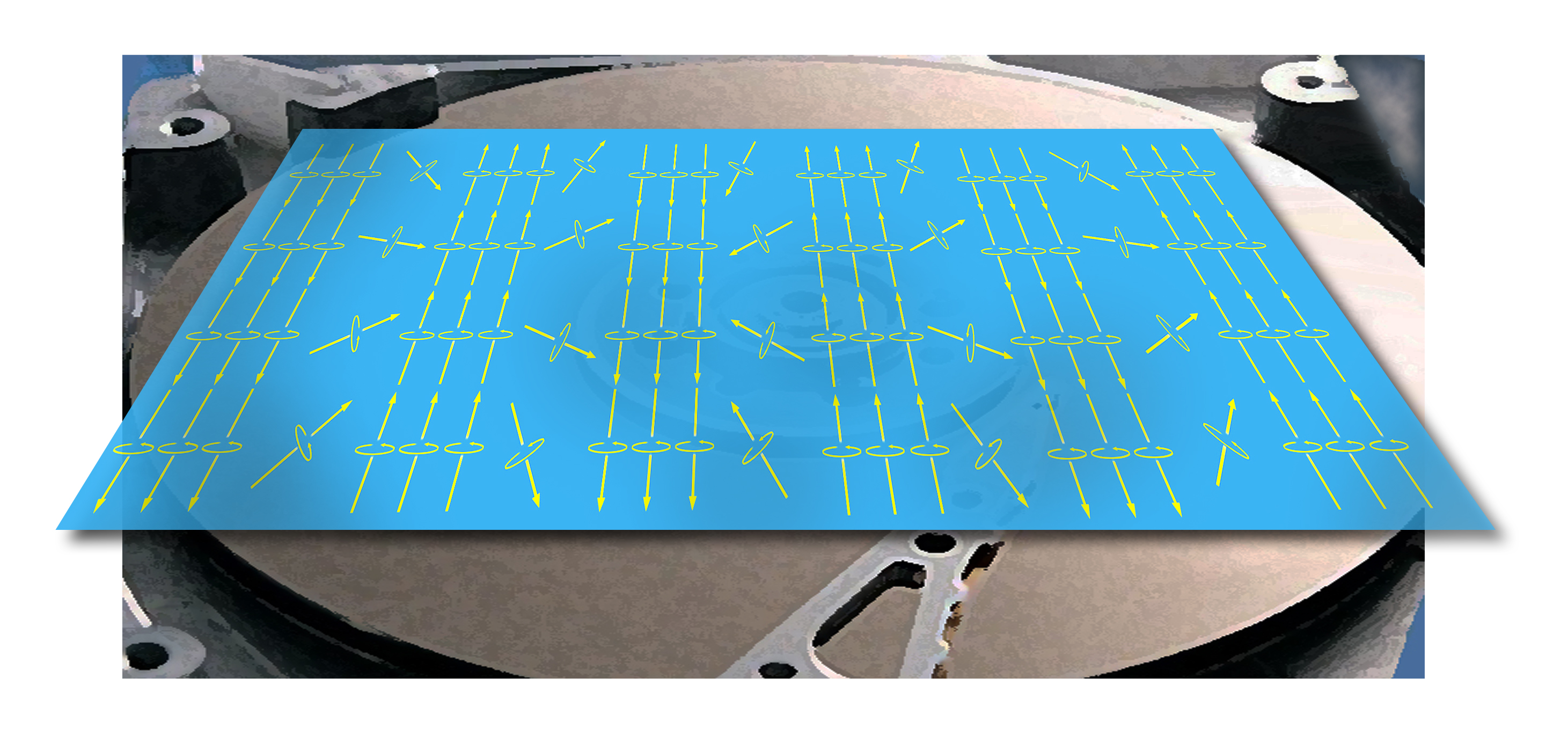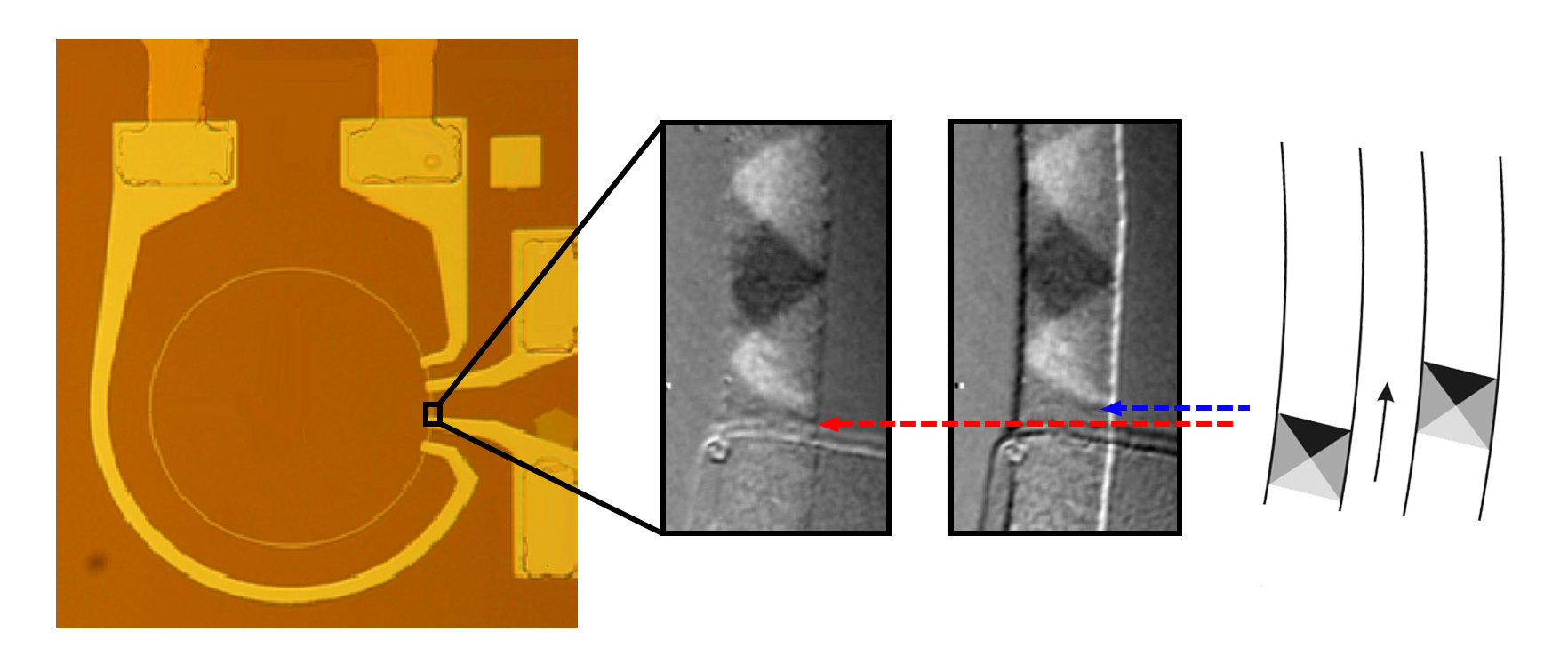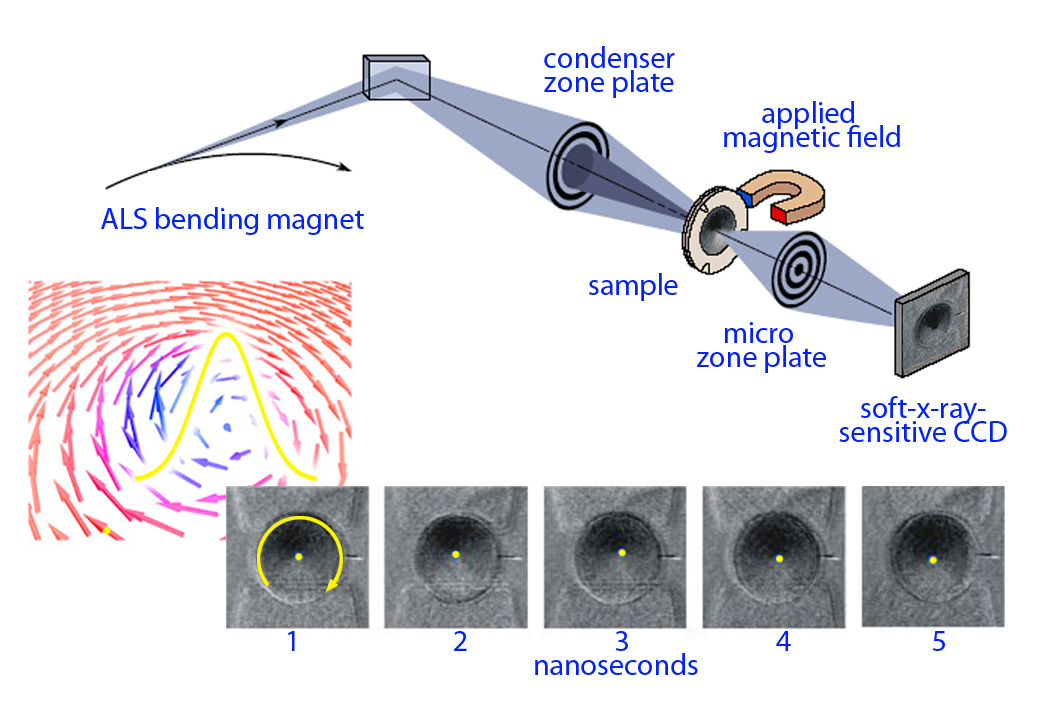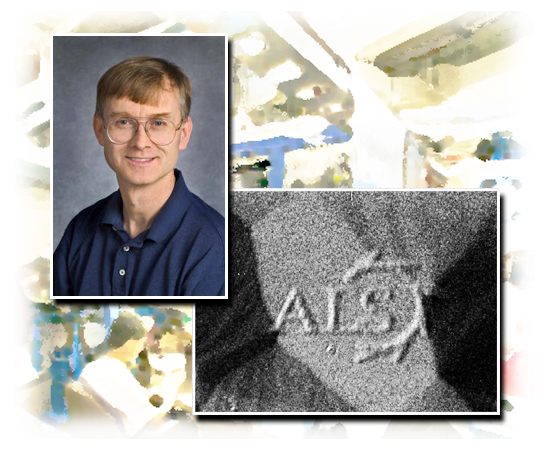Contact: Paul Preuss, (510) 486-6249, [email protected]
“One of the most challenging areas of research in nanoscience is magnetism,” says Peter Fischer of the Center for X-Ray Optics, in Berkeley Lab’s Materials Sciences Division.
Fischer and his colleagues explore ways to control magnetic properties in the ultra-fast, ultra-small electronics of the future with magnetic soft x-ray microscopy. They use the x-ray microscope at beamline 6.1.2 of the Advanced Light Source (ALS) to study magnetism on the nanoscale, where distances are measured in billionths of a meter.
“Nanoscale magnetics is the reason the storage capacity of computers has increased three orders of magnitude in a decade,” says Fischer. “It’s why we can store hundreds of gigabytes on a laptop.” The watershed was the discovery of giant magnetoresistance (GMR) in 1988; soon the phenomenon was applied to read heads that allowed faster reading and closer packing of the magnetic domains on a computer hard drive.
Magnetic domains can encode a 1 or a 0, the two letters in a computer’s binary code, depending on the orientation of the spin direction of the domain’s electrons – which can be “up” or “down”, i.e. a logical 1 or 0. GMR launched a new kind of electronics, spin electronics (spintronics), which allows manipulation of electron spins in addition to charges, the basis of conventional electronics.
In the near future, spintronics may make rotating disks a thing of the past. One promising concept is “racetrack memory,” which reads data from magnetic domain walls moving along a nanowire. In racetrack memory, domain walls – regions where collective electron spins reorient from one domain to the next – are the bits that encode the data.
Using beamline 6.1.2, Fischer and his colleagues showed that pulses of spin-polarized current (a spin current is one with a high proportion of electrons having the same spin orientation) could drive domain walls along a nanowire at up to 110 meters per second, much faster than the rate a spinning disk’s domains pass a read head. Unfortunately, in this experiment the domain-wall motion varied randomly, instability that would make memory unreliable.
A better understanding of spin currents is essential. In a recent experiment Fischer and his colleagues directly measured a current’s degree of spin polarization for the first time, as it moved the core of a magnetic vortex in a ferromagnetic alloy of iron and nickel (Permalloy).
“Studies of how we can better understand and control spin-polarized currents for manipulating magnetic elements are just a sample of the numerous explorations of magnetism on the nanoscale that soft x-ray microscopy makes possible,” says Fischer. “Magnetism is the oldest mystery in the world, and there are more than enough questions to keep scientists busy for a long time to come.”
Want more details? Read on.
A pioneering x-ray microscope adds powerful capacity for magnetic studies on the nanoscale
Under the direction of Peter Fischer of the Center for X-Ray Optics in Berkeley Lab’s Materials Sciences Division, the XM-1 x-ray microscope at beamline 6.1.2 of the Advanced Light Source has been optimized for the study of nanoscale magnetic behavior. In addition to features of practical interest to the electronic devices of the future, Fischer and his colleagues are seeking paths to investigate magnetism on the most fundamental length and time scales.
One of the most fruitful areas of investigation is how magnetic elements are affected by spin-polarized currents, where a large proportion of the electron spins are oriented in the same direction. This field of study was given enormous impetus beginning in 1988. In that year two scientists working independently, Peter Grünberg of Germany and Albert Fert of France, discovered giant magnetoresistance (GMR), for which they received the Nobel Prize in Physics in 2007. Nine years later IBM made read heads for computer disks using the principle of GMR, a technology that has become an industry standard.
Until then most electronic devices had depended solely on the manipulation of electronic charge, and most still do. Transistors work by controlling the movement of negatively charged electrons (and positively charged “holes”) through solid-state circuitry. A solar cell converts the energy of sunlight into a flow of electrons and holes; an LED does the reverse, converting an electric current into light.

The 1s and 0s of binary code are represented by magnetic domains of opposite orientation. In the domains, electrons with similar spin tend to align, either “up” or “down,” but in the domain walls between them spins are in a transitional state. GMR read heads register not just the magnetic field orientation of the domains but the spin orientation of their constituent electrons.
GMR read heads were an early example of a different kind of electronics, however – not charge electronics but spin electronics, or spintronics. Spin is a quantum mechanical property of electrons having two values, up and down; each spinning electron generates its own tiny magnetic field. In a ferromagnet (because of the quantum mechanical exchange interaction and the Pauli principle), the electron spins tend to line up to minimize their interaction energy. Through a different interaction (the Zeeman interaction), the spins interact with external magnetic fields.
So when a GMR read head passes over a magnetic domain in a spinning computer disk, whose field orientation encodes a 1 or a 0, the electrons in the free magnetic layer of the head align themselves with the field of the domain. Another layer of the head, the pinned layer, is not free to change orientation. The electron spins of the two layers are sometimes aligned and sometimes opposite. In the former case, current flows freely and the head registers a 1. In the latter case, giant magnetoresistance comes into play: the opposing electron spins in the two layers resist the passage of current, and the head reads a 0.
At present, writing 1s and 0s on a computer disk (as opposed to reading them) is still done the old-fashioned way, using a charge current in the write head to induce magnetic fields on the disk’s domains. But, says Fischer, “Applying a magnetic field is not the smartest way to flip a domain.” The future belongs to spin currents.
Memories of the future
When it comes to storing vast amounts of data, and writing and reading that data rapidly, mechanically spinning disks may soon be a thing of the past. A promising concept for using spin currents to read and write data is to push magnetic domain walls along a nanowire. As on a hard drive, the magnetic domains on the wire each have a characteristic orientation, but it’s the domain walls, in which the collective electron spins are structured as a smooth transition from one state to its opposite, that constitute the bits of information.
A highly polarized spin current exerts torque on the spinning electrons in the domains; by changing their orientation, it effectively moves the domain wall in the direction of the current. A dense spin-polarized current could propel domain walls along the wire past a fixed read head at a much higher rate than a spinning disk can move domains past a head at the tip of a boom.
A scheme to create such a memory on a silicon chip, called “racetrack memory,” was patented in 2004 by IBM’s Stuart Parkin. In 2007, Peter Fischer and colleagues, including Guido Meier and associates from Germany and Dong Hyun-Kim of South Korea, used the ALS’s XM-1 x‑ray microscope to show that injecting nanosecond pulses of high-density spin-polarized electrons into a stretch of ferromagnetic nickel-iron nanowire could drive domain walls rapidly along the wire. Images made by the XM-1 before and after the pulses were injected showed that the domain walls moved up to 110 meters per second, extremely fast on the nanoscale, although movement was random. Such instability would make reading and writing to memory unreliable. (Although racetrack memory has recently been demonstrated in a few operations, the technology still seems to be a long way from coming to market.)

By applying an external magnetic field, domains and domain walls are created between contact pads in a circular Permalloy nanowire. A one-nanosecond pulse of spin-polarized current is launched into the wire and pushes a domain wall up to 110 nanometers, a velocity of 110 meters per second.
To overcome these difficulties, a better understanding of spin currents is essential. In a recent experiment, instead of pushing domain walls along a nanowire Fischer and his colleagues, including Shinya Kasai and associates from Japan, directly measured for the first time the degree of spin polarization in a current as it moved the core of a magnetic vortex in a ferromagnetic material. The measurement was a demonstration of the ability of imaging with soft x-ray microscopy to examine essential parameters in spintronics and magnetism.
Circular magnetic vortices form in ferromagnetic thin-film disks to compensate for the increased magnetic energy at the center of a circulating spin configuration. The middle of the twisting field rises above or descends below the plane of the disk: this is the magnetic vortex core. A spin-polarized current exerts torque on the electrons in the vortex and moves (translates) the core in a circular motion with respect to the center of the disk.
The degree of spin polarization of a current is the proportion of all the electrons in the current which have their spins aligned – in other words, the spin-current density divided by the total current density. In the magnetic vortex core experiment, the total current density was known and the observed radius of the core’s circular motion was proportional to the spin-current density. Thus the degree of spin polarization could be measured directly.
Imaging nanoscale magnetics
The experimental set-up at ALS beamline 6.1.2 focuses a beam of circularly polarized x-rays using a zone plate (zone plates, which are Fresnel lenses, are specially fabricated by the Center for X-Ray Optics to achieve spatial resolution approaching 10 nanometers). The focused monochromatic x-ray beam, with its energy tuned to an element-specific absorption edge, is then passed through the sample. (In an x-ray absorption spectrum, an absorption edge indicates that photons corresponding to the energy of a specific electron shell have been absorbed; the absorption edge unambiguously identifies the element.) The transmitted x-rays are projected onto a CCD by a second zone plate and form a full-field image.
Through their interactions with spinning electrons, circularly polarized x-rays reveal the orientation of the spins in a ferromagnetic material and can be used to study the material’s magnetic properties. X-ray magnetic circular dichroism (XMCD) is a technique in which a magnetic field is applied to the sample; the spectra of left and right circularly polarized x-rays are tuned to the edge marking the electron shell responsible for the material’s magnetic properties and are compared: in the resulting image, one orientation appears dark and the opposite orientation light.
In the magnetic vortex core experiment, the sample to be observed was a disk of nickel-iron alloy (Permalloy) 40 nanometers thick and 1.5 micrometers in diameter, layered on a silicon substrate 200 nanometers thick. Alternating current was sent through the sample through two 80-nanometer-thick gold electrodes. The pulses of x-rays from the ALS were 70 picoseconds long and separated by 328 nanoseconds, so to resolve the rotation of the vortex core within these time intervals, the spin-polarized ac current that moved the core (each pulse sequence a relatively long 100 nanoseconds) had to be synchronized with the x-ray pulses.

By using x-ray magnetic circular dichroism at beamline 6.1.2, the orientation of the magnetic vortex in the Permalloy disk is revealed and the motion of the vortex core relative to the center of the disk is imaged. In this experiment the core made a complete circuit of the center of the disk in five nanoseconds.
Because of the high brilliance of the synchrotron source, each of the numerous x-ray pulses contains relatively few photons and thus acts as a strobe, capturing the instantaneous state of the magnetic vortex core. The resulting series of images showed the core rotating in a clockwise direction under the influence of the spin-polarized current, making a complete circuit of the center of the disk in five nanoseconds.
Unending opportunities
“These studies of how we can better understand and control spin-polarized currents for manipulating magnetic elements are just a sample of the numerous explorations of magnetism on the nanoscale that magnetic soft x-ray microscopy makes possible,” says Fischer. “Many factors affect magnetism on this scale, and many of these factors interact with one another. For example, heat-assisted magnetic recording takes advantage of weaker magnetism at higher temperatures. Another approach is bit-patterned media, in which each domain is contained on a separate grain and information can be packed more densely.”
Recently Fischer collaborated on a patterning investigation with Tiehan Shen of the University of Salford in the United Kingdom, Simon Morton of Berkeley Lab’s Physical Biosciences Division, and David Kilcoyne of the ALS, using a focused-ion-beam Nanowriter at Salford to implant gallium ions in thin iron films, creating patterns with modified magnetic and chemical properties.
The size, shape, and concentration of gallium in the patterned features influences their magnetic properties. In addition to straightforward geometrical shapes, the researchers threw in a couple of more unusual patterns: the Berkeley Lab logo and the logo of the ALS, drawn on the nanoscale.
“Nonregular patterns are not really the scientific focus of our work,” says Fischer, who with Mi-Young Im of the Center for X-Ray Optics combined magnetic and nonmagnetic images to bring out the details, “but we did find that the ALS logo in particular, with its schematic pattern of beamlines, showed a preferred pinning of the magnetic domains to those beamlines.”

The XM-1 microscope reveals pinning of magnetic domains in a nanoscale ALS logo patterned by implanting gallium ions in thin iron. Peter Fischer has optimized ALS beamline 6.1.2 for the study of nanoscale magnetic behavior.
The magnetic ALS logo serves as a tribute to the science made possible by a premier third-generation synchrotron light source. Advances are still possible with such machines, says Fischer – he names the introduction of “pseudo-single-bunch operation” at the ALS, in which just one of the hundreds of bunches of electrons circulating in the ALS ring will be kicked into a slightly different orbit. The bunches in the separate orbits—the single bunch providing a time signal and the others a near-continuous flow—will be used to provide both pump and probe x-ray pulses, something now available at the ALS only a few weeks in the year. (In a pump-probe experiment, one pulse excites the sample – as, for example, the spin-polarized electric current did in the magnetic vortex core experiment – and the other pulse probes the result, as the soft x-rays did in that experiment.)
“As clever as these upgrades will be, augmenting what is already one of the most versatile x-ray microscopes in the world, and the only one that can provide full-field magnetic imaging, to advance to the most fundamental time and length scales will require a new generation of light sources,” says Fischer. “The source I have in mind is a soft x-ray free-electron laser.”
Such a custom-fitted free-electron laser, or FEL, is the kind of tailored FEL that might be a part of Berkeley Lab’s Advanced Photon Science Initiative, the proposal to build a FEL with up to 10 experimental end stations, all driven by a single superconducting linac.
“Magnetism is the oldest mystery in the world,” says Fischer, “and there are still more than enough questions to keep scientists busy for a long time to come.”
Additional information
More about the Center for X-Ray Optics and beamline 6.1.2 can be found at http://www-cxro.lbl.gov/
More about x-ray imaging of magnetic domain walls driven by spin-polarized currents can be found at http://www.als.lbl.gov/als/science/sci_archive/153domainwall.html
More on the direct measurement of the degree of a current’s spin polarization will appear in Physical Review Letters, “Probing the spin polarization of current by soft X-ray imaging of current-induced magnetic vortex dynamics,” in press.
More about Peter Fischer’s research is at http://pjfischer.lbl.gov